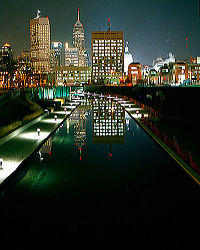 Photography
is both an "art" and a "science." The "science" concerns itself with
the technical aspects of light, camera bodies, shutters, lenses and films.
Understanding the "science" is essential to good photography, but will
not result in good photographs by itself. It is only part of the
knowledge required. The other half is the "art" which applies the
"science" to create something aesthetically pleasing to the eye and interesting
to the viewer. Over time a classic set of guidelines has developed
describing compositional elements found in what are considered superb photographs;
ones that are pleasing to the eye and hold the viewer's interest.
I use the term "guidelines" as they are not absolute, nor do all
apply to every photograph. Knowing which ones to use alone or in
combination, and when to break one of them cannot be easily taught, but
requires experience finding what works for a specific subject, venue, and
what the photograph is intended to portray. One cannot learn and
master it first, and then take photographs. It requires practice,
experimentation and study of what looks good and what doesn't afterwards.
Intertwined in this are references to elements of the "science" as this
covers its application.
Photography
is both an "art" and a "science." The "science" concerns itself with
the technical aspects of light, camera bodies, shutters, lenses and films.
Understanding the "science" is essential to good photography, but will
not result in good photographs by itself. It is only part of the
knowledge required. The other half is the "art" which applies the
"science" to create something aesthetically pleasing to the eye and interesting
to the viewer. Over time a classic set of guidelines has developed
describing compositional elements found in what are considered superb photographs;
ones that are pleasing to the eye and hold the viewer's interest.
I use the term "guidelines" as they are not absolute, nor do all
apply to every photograph. Knowing which ones to use alone or in
combination, and when to break one of them cannot be easily taught, but
requires experience finding what works for a specific subject, venue, and
what the photograph is intended to portray. One cannot learn and
master it first, and then take photographs. It requires practice,
experimentation and study of what looks good and what doesn't afterwards.
Intertwined in this are references to elements of the "science" as this
covers its application.
WARNING: Study and practice at the photographic art will result in never viewing the world around you the same way again. You will be forever changed! So will your photographs.